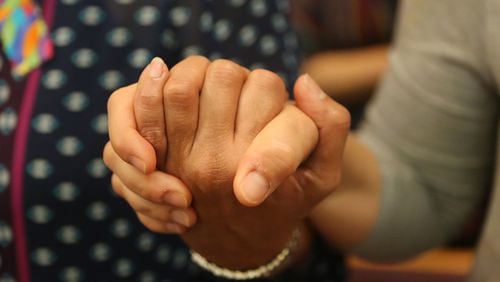It was 7 on a Sunday morning, and the world was waking up to the heart-breaking news: Hours earlier, a gunman filled with hate had opened fire inside a gay nightclub in Orlando.
Jennifer Brett, a features reporter for The Atlanta Journal-Constitution, saw the alert on her phone first thing that morning.
Curtis Compton, one of the newsroom’s photographers, had pulled into the parking lot of his church when his supervisor called him. Compton’s first assignment wasn’t until 2 that afternoon, but like any good newsman, the tools of his trade – his cameras and lenses – are always with him.
Ernie Suggs, our newsroom’s race relations reporter, sent a note to his editor after seeing some early, yet frantic, chatter on Slack – our internal messaging system. “If you need anything,” he told his editor, “let me know.”
Our first newsroom-wide meeting took place at 10 a.m. When the call began, the death toll stood at 20. By the time it was over, we had learned the gunman, Omar Mateen, who was shot and killed by police, had taken 49 lives.
Compton, Brett and Suggs had already been dispatched to Florida. Rather than book a flight, Compton decided to drive. As the photographer assigned to cover the Braves, it’s a trip he’s made many times before during Spring Training.
But this was no ordinary trip.
During the drive, Compton couldn’t shake the thought that the killer purposefully targeted a gay nightclub. He contacted one of his best friends, who is gay. “I’m sorry to say, but I’m on my way to Orlando to cover this story,” Compton told the man. “My first thought was you.”
Like Compton, Brett kept up with the disturbing updates en route to Orlando. She, too, was shaken by what she learned. “I remember asking myself, ‘How can I do the best job of covering this horrific event?’”
By noon, more than 30 journalists had gathered in our newsroom. No one called them. No one asked. They were here to help cover the news: Stories of heartbreak and heroism had to be written and shared with our readers. Images capturing the distress and despair had to be photographed. Our digital platforms needed to provide readers with real-time updates – and share useful information on how to help the victims and their families.
At 3:55 p.m., we published a special afternoon edition on our digital replica and made several key decisions: We settled a debate about whether we could use the word “massacre” in our coverage. We decided to post a picture of the suspect on our websites after learning The Washington Post confirmed it was indeed a photo of Mateen. And we agreed to add an eight-page special section to Monday morning’s newspaper.
By 6 p.m., Brett, Suggs and Compton had finally arrived in Orlando. If we were to meet our print and digital deadlines, stories and photographs would need to be gathered, transmitted and edited – and quickly.
How do you do that when you’ve just landed in a strange place? In the middle of a major crime scene? With the clock ticking?
“The hardest part,” Suggs said, “is just trying to make all of the arrangements to get there. Once you’re there, your journalistic instincts kick in.”
Said Brett: “It’s about quickly making connections. You want to be respectful. You want people to know, ‘I’m here because you matter, because the person you love matters and because this story matters.’”
At 10:30 p.m., we put our newspaper to bed, meaning it was now ready to go onto our printing press.
Yet, as midnight neared, Suggs continued to monitor the heart-breaking scene outside the Orlando nightclub. Anxious friends and family members were waiting to hear word about their missing loved ones. Inside the club, cellphones, still in the pockets of the dead, chirped and rang with frantic messages that would forever go unanswered.
It was that detail, Compton later admitted, that unnerved him the most. In his 20-plus years with The Atlanta Journal-Constitution, Compton has been to Iraq – four times – to cover the war. He’s seen more dead bodies than he cares to remember. The story of the cellphones, he said later, “really hit me,” making this his most difficult assignment.
Journalists know we mustn’t interject ourselves into stories. We’re there as observers. But that’s not always easy.
Brett, for example, talked to one young woman, Julissa Leal, whose brother, Frank Hernandez, had been inside the nightclub with his boyfriend when the shooting began. Leal and family members drove from Louisiana, desperate for information. “He was the best person I ever knew,” Leal told Brett. “I just wish I could see him again.”
Brett remembers the fear, trepidation and anxiety in the woman’s eyes.
“What you really want to do is put your arms around this poor lady and cry with her,” Brett said. “It’s jarring to be present when people are going through the worst moment of their lives. But you want to be respectful of boundaries.”
For Suggs, one of the most emotional moments came during a memorial service Monday night, as the names of the 49 victims were read aloud.
“For me,” Suggs said, “hearing those names really put it in perspective. As journalists, we’re objective, but these were human beings who days earlier had been hanging out and having fun. Now they’re gone.”
So why would we invest so much time and resources in covering this story? Why send our own journalists to Orlando?
Because it’s our duty to document the events that shape the world around us. No matter how disturbing they might be.
“It starts from a point of caring,” Brett explained. “The whole world was watching this story, and the whole world was grieving. No matter what I was doing, or who I was talking to, I wanted to keep the world’s broken heart in mind.”
And that, at its essence, is what we do and why we do it.
About the Author







